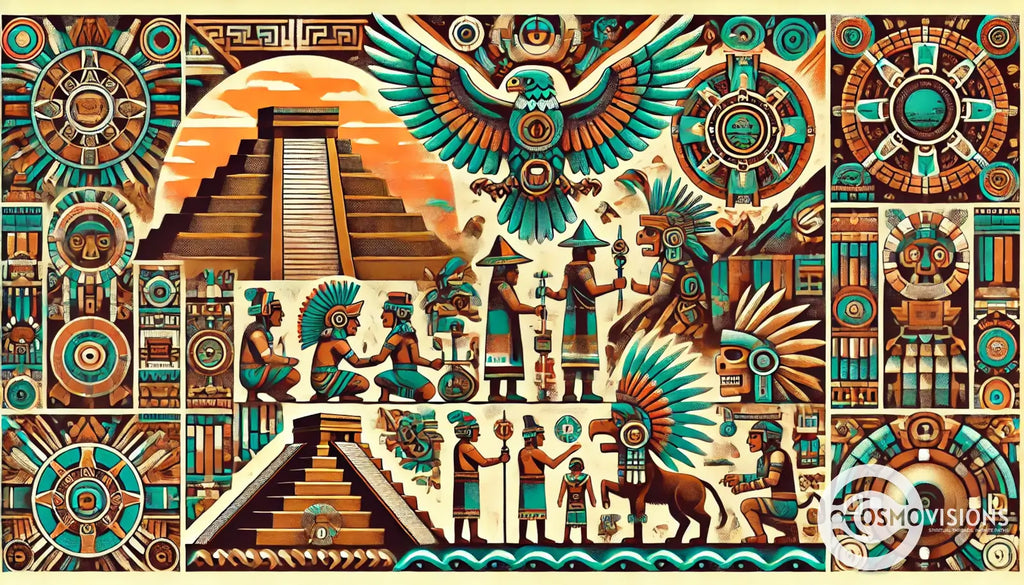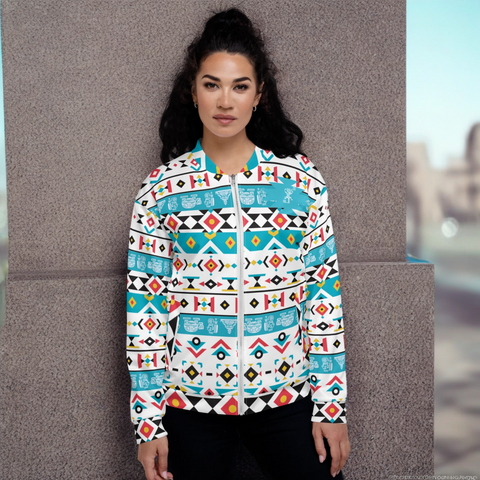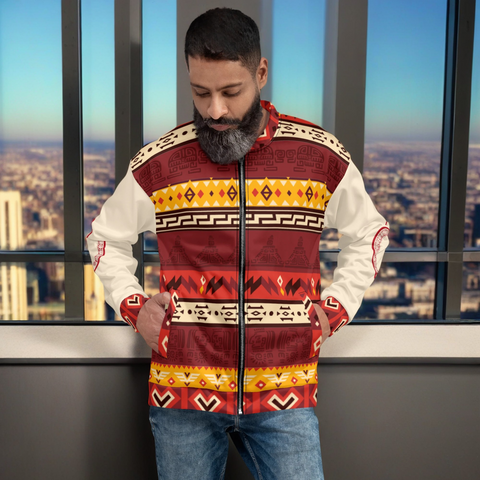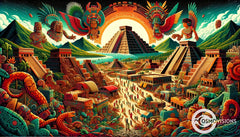Exploring Traditional Aztec Ceremonies and Religious Practices: Unveiling the Fascinating Aztec Rituals
Posted by Massimiliano Geraci

People often wonder about the mysteries of past civilizations. They ask, “How did those people live? What did they believe?” One such fascinating group is the Aztecs. Their rituals and beliefs shaped a powerful society. The influence of ancient Mexico, particularly the Aztec culture, continues to affect contemporary Mexican beliefs and rituals around death, highlighting a through-line from pre-Hispanic times to modern practices.
One key fact: The Aztec civilization was not shy about using human sacrifice in its religious practices. It pleased its gods and kept the world moving. Our article will shed light on these ceremonies and how they were part of daily life for the Aztecs.
You will learn why rituals were important, from pleasing gods to marking time with their unique calendar.
We’ll make it easy to understand why these practices mattered so much to them. Ready to explore?
Key Takeaways
1. Aztecs held ceremonies every month to connect with the gods, showing respect through rituals like human sacrifice.
2. They worshipped many deities, each requiring different offerings for things like warfare success and rain.
3. The Aztec calendar guided when to perform sacred rituals, aligning actions with celestial signs for harmony.
4. Festivals were colorful events that honored gods and nature, asking for blessings through dances and offerings.
5. According to Aztec belief, human sacrifice played a vital role in keeping cosmic balance, from grand ceremonies at temples in the Aztec capital, Tenochtitlán, to personal acts of bloodletting.

The Role and Importance of Rituals in Aztec Religion
Rituals held a special place in the life of the Aztec empire. They linked the seasons, agriculture, and human existence to divine forces. At least one major religious event took place every month, focusing on this deep connection.
These practices were not simply traditions; they served as vital communications with deities like Huitzilopochtli and Tlaloc. Through these ceremonies, people showed respect for the gods’ sacrifices by offering their own.
Human sacrifice stood out among these rituals. This act was seen as a crucial way to honor and feed the gods, ensuring the sun rose each day and rains nourished crops. Aztec priests carried out these offerings at sacred sites such as Templo Mayor in Tenochtitlan, where believers gathered to witness acts of devotion on the sacrificial stone.
Every ceremony—be it a small bloodletting or grand sacrificial event—reinforced Aztec society’s values and its unbreakable bond with celestial beings.
The Influence of Deities, Including the Sun God, on Aztec Ceremonies
Aztec ceremonies were deeply connected to their gods. They worshipped many deities, and each had a special role. Huitzilopochtli, the god of combat, demanded blood through warfare.
Tonatiuh, the sunlight deity, needed human hearts to rise each morning. The rain god Tlaloc took care of rain but asked for lives in return. Quetzalcóatl, represented as a Plumed Serpent, shared wisdom and was involved in the creation of humans.
During these events, Aztecs met at grand temples and pyramids. Priests carried out rituals that honored their beliefs about life, death, and rebirth. For instance, they believed offering human flesh helped nourish the cosmos and balance nature’s cycles.
Festivals like Toxcatl celebrated Tezcatlipoca by mirroring his traits—powerful yet mysterious. Each ceremony reflected deep respect for their gods’ desires and teachings on how to live well within Aztec society. The collective act of sacrifice by all the gods for mankind to live was a central theme in these rituals.

Understanding Aztec Cosmology and the Concept of Heavens in Rituals
Aztec cosmology depicted the universe as a vast and complex structure. It was divided into thirteen heavens above the Earth and nine underworlds below it. Each of these layers had its own gods and symbols.
The Aztecs thought that time moved in cycles, each ending in destruction only to start anew with the creation of a different world. This cycle of creation was vital to their religious ceremonies, where they sought to honor the gods who controlled their destiny through ritual acts. They believed they lived under the fifth and final sun, a period destined to end through movement, possibly resulting in catastrophic events. This belief underscored the importance of sacrifice and the continuous cycle of death and rebirth in their cosmology.
The tonalpohualli, or calendrical round, was crucial in determining human fate and interpreting celestial signs. The Aztecs used this 260-day calendar not just for farming or politics but also to decide when to perform sacred rituals which would please specific deities responsible for rain, agriculture, war, and even the balance between life and death. To understand our place within the cosmos is to align ourselves with forces greater than us—forces that guide seasons, stars, life itself.
The Practice of Human Sacrifice by Aztec Priests in Aztec Culture
Aztec human sacrifice was a dark but fundamental aspect of Aztec spirituality and religious rituals. The Aztecs believed that such sacrifices were essential to keeping the cosmos in balance and ensuring the sun rose each day.
One of the most significant events occurred in 1487 during the reconsecration of the Great Pyramid of Tenochtitlan, where 80,400 prisoners met their end over four days. This extreme act wasn’t just about death but deeply embedded in their understanding of cosmology and connection with divine forces. Ritual human sacrifice was significant as it encompassed spiritual, survival, and social stratification aspects, reinforcing the Aztec worldview.
Offerings weren’t always so grim for sacrificial victims. Some ceremonies called for personal bloodletting or small creatures instead of human lives. These acts, whether grand or modest, were expressions of deep faith—ensuring fertility for crops and aligning mortal endeavors with celestial rhythm. Human beings were seen as divine entities whose sacrifices were necessary to sustain the world and repay the gods.
High priests played crucial roles in these rites, acting as bridges between humans and deities like Quetzalcoatl or Tlaloc—the god associated with rain. Through these practices, shared by other Mesoamerican societies too—yet distinct in scale within Aztec civilization—they sought harmony with both natural elements and revered spirits across history.
The Significance of the Aztec Calendar in Religious Ceremonies
The Aztec calendar played a crucial role in shaping religious events. This unique system included a 365-day solar year and a 260-day sacred period. Each of the eighteen twenty-day months in the solar year had its own theme, guiding which ceremonies took place.
The most awe-inspiring event was every 52 years—the New Fire Rites. Communities stopped all normal activities to welcome this time, lighting new fires as symbols of renewal and continuity.
Religious leaders relied on this calendar to decide when to honor gods and ancestors. Sunset rituals, dawn prayers, and offerings were timed carefully with the solar and sacred cycles.
The New Fire Rites especially showed faith in cycles of destruction and rebirth that governed cosmic order. Modern excavations in Mexico City have uncovered evidence of these rituals, including findings at the Templo Mayor excavation site that reveal the extent of human sacrifice and ritual cannibalism among the Aztecs. During these rites, Aztecs expressed deep reverence for forces larger than themselves—showing gratitude for life’s gifts and respect for nature’s power by starting anew, guided by celestial movements marked on their intricate calendar wheels.

Traditional Aztec Festivals and Their Symbolism
Aztec festivals were full of color and life. They connected people with gods and the natural world.
1. Tlacaxipehualiztli marked spring’s arrival. Warriors wore enemies' skins to honor Xipe Totec, god of renewal. This act symbolized new beginnings and the earth’s rejuvenation.
2. Toxcatl celebrated Tezcatlipoca, the god who could see all. A chosen person lived as Tezcatlipoca for a year and was then sacrificed, which showed life’s fleeting nature and divine will.
3. The Mesoamerican ballgame wasn’t just a sport; it held deep religious meaning. Losers often faced sacrifice, linking death to honor and the cycle of life.
4. Feast days for gods like the rain deity brought communities together to pray for fruitful harvests. Dance, offerings, and feasts aimed to please these powerful beings in exchange for their blessings.
5. The calendar played a critical role in scheduling ceremonies. Important events aligned with celestial movements, showing time’s sacredness in Aztec belief.
6. At Huey Tozoztli, people paid homage to maize goddesses with dances and flowers, thanking them for crops’ growth and praying for future abundance.
7. Ochpaniztli involved sweeping rites to cleanse homes and streets, preparing spaces for blessings and positive energy from deities like Tlaloc, the god of rain.
8. Each month had its own festival; celebrations linked daily life closely with spirituality and cosmic forces. Specific Aztec rituals, such as the sacrifice of captured warriors and ceremonies involving the Aztec Sun Stone, were performed to honor the gods and reinforce the political significance of battle for the Mexica people.
Conclusion: The Lasting Legacy of Aztec Ceremonies and Religious Practices
We have journeyed through the heart of Aztec spiritual life. Their rituals paint a picture of a society deeply connected to their gods and the natural world. From the sun's path across the sky to the deepest shadows, every moment held meaning.
The Aztecs showed us how to live in harmony with cosmic forces, honoring them through ceremonies that still whisper to us today. This ancient wisdom invites us to see beyond ourselves, into a universe where every heartbeat echoes the drumbeats of Aztec dances long past.
For a deeper understanding of the intricate layers of Aztec beliefs, explore our comprehensive article on Aztec cosmology and the concept of heavens.
FAQs
1. What did Aztec ceremonies involve?
Aztec ceremonies were full of rituals and sacrifice to honor their many gods, like the sun god and the god of war. They believed these practices kept the world balanced.
2. Who were important gods for the Aztecs?
The Aztecs worshipped several important gods including Quetzalcoatl, the feathered serpent, and Tezcatlipoca, representing life's changing nature. Both played key roles in mythology and daily worship.
3. Why did Aztecs perform human sacrifices?
Aztecs performed human sacrifices to feed their gods with vital energy, ensuring the sun rose each day and crops grew. They thought this pleased the gods and secured their protection.
4. Did all Aztec rituals include sacrifice?
No, not all rituals involved sacrifice. Many included offerings like feathers or food to communicate with deities or celebrate religious festivals without harming anyone.
5. How did religion shape Aztec life?
Religion was central to Aztec life; it influenced everything from politics to agriculture. Priests held great power, guiding people to live according to divine will.
6. Were children taught about these practices?
Yes, children learned about their culture’s religious traditions early on through stories, songs, and participating in various ceremonies alongside adults.





















